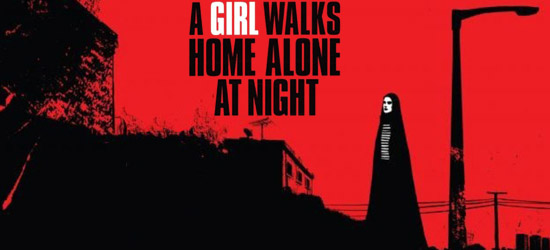Directed by: Ana Lily Amirpour
Written by: Ana Lily Amirpour
Stars: Sheila Vand, Arash Marandi, Marhsall Manesh
In “Bad City,” no one is safe.
The film opens on a young man, standing far left, next to what appears to be a dumpster. He wears a white t-shirt and jeans, like James Dean. He disappears into the structure and returns with a cat in hand. The man then walks away from the camera, looking back only once. We watch as he trails down a long, straight road.

Ana Lily Amirpour’s A Girl Walks Home Alone at Night unfolds slowly; following the trail of this establishing shot, the film reveals details only when appropriate while leaving no stone unturned. The narrative comes to us in pieces through detailed shots and rather sparse dialog.
With that in mind, there are a few individual scenes worth delving into.
The first close up of the film is of a woman’s face, fully made-up. She bats her eyelashes at the young man walking by, releases a coy smile and follows him hungrily with her eyes. We watch her watching him, a reversed gaze that continues once the Girl is introduced. (Although truth be told I wish the Girl would command more of the camera. We see the first half of the film mainly from Arash’s perspective.)

In one scene, the Girl—really, the Vampire—dances alone in her barren room to American-sounding music, surrounded by posters of Madonna and other Western icons. We compare this image to that of the drug dealer in his lavish home, as he listens to electronic music, snorts coke and counts money. He lifts weights while making eye contact with the vampire.
She doesn’t speak, yet her mouth is responsible for her victims’ deaths, like a siren without a song. Actually, the first time we hear the vampire speak, she is addressing a young boy. She asks him, repeatedly, “Are you a good boy?” Perhaps she sees a spark of innocence in him, a chance for this child to grow up a decent man, unlike the criminals and junkies whom she targets.


For the first half of the film, the camera pays strong attention to characters’ mouths. We see objects entering mouths: cigarettes, fingers, candy, pills and we watch them disappear into dirty abysses. The extreme close-ups move from mouths to eyes during the second half of the film as tones shift from sensual to reflective. Hossein becomes fixated on the cat’s eyes and even the headlights on Arash’s car look like eyes opening.
Since AGWHAAN is, after all, a monster movie shot in black and white, there is no doubt that the film reflects aspects of drama/thrillers from the 1950s. Aras, the James Dean look-alike, drives a vintage car, his prized possession. In a scene where Arash proclaims his love for the Vampire, the two stand by a freight train, a factory in the background. The mise-en-scene makes me think of On the Waterfront, with Arash in place of a madly-in-love Marlon Brando. The film’s slower pace, sound effects and drama are reminiscent of old Hollywood, though its script is not heavy on dialog, unlike 40s and 50s melodrama or sci-fi thrillers.

In fact, on a completely different level, AGWHAAN reminds me of Jonathan Glazer’s 2014 sci-fi thriller, Under the Skin. But instead of Scarlett Johansson playing extraterrestrial “femme fatale” we have actor Sheila Vand as a blood-sucking antihero.
Of course, we cannot read either of these films without addressing their feminist elements. In Under the Skin, Johansson’s character reverses the male gaze by targeting and stalking men as she cruises around urban Scotland. The vampire in AGWHAAN plays a similar role, observing crooks on the streets of “Bad City.”
Then there is the supernatural aspect of both female protagonists. Obviously neither character is human, so the narratives work on a suspension of disbelief. Arguably, this suspension of disbelief creates more “wiggle room” for the development of the feminine narratives. In other words, a nonhuman female character (i.e. the vampire) may be more likely to pass as a killer or to possess authority than a human female (i.e. the Prostitute, who is under the control of her pimp). And, of course, her primary weapon is still her physical appearance. There seems to be a struggle in feminist cinema to create female antiheroes that do not play into the femme fatale stereotype. (Although Marvel’s TV series “Jessica Jones” comes close.)
That being said, it is undeniably empowering to watch a woman defend herself—and other women— against oppression and assault, whether or not she is “technically” human. Either way, she’s badass and genuinely scary.
At its darkest points, AGWHAAN is like Requiem For a Dream meets Blue Velvet. We are taken into drug dens and private bedrooms, through a dilapidated cityscape and a well-to-do neighborhood. We see people through a fish-eye lens, shaky cam shots and at least one notable POV shot (where a young boy pulls on his mother’s arm). The director of photography, Lyle Vincent, plays with both wide and telephoto lenses in a style that is both experimental and classical. The result is a film that feels like something I shouldn’t be watching and yet I can’t take my eyes off of it.
— SDC
